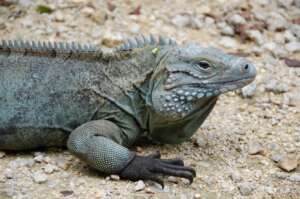Hark, O reader of the Keeper Blogs! I—Daniel!—have come to talk about iguanas. And not just any iguanas, but some particularly cute ones: the Grand Cayman blue iguana (Cyclura lewisi) and the San Salvador iguana (Cyclura rileyi rileyi).
I’m going to go out on a limb and assume that, given that you’re the kind of person who reads zoo blogs, you probably already know what an iguana is. But these aren’t the common sort of iguanas that you find falling out of trees in Florida; that’s the green iguana (Iguana iguana). The genus Cyclura is the rock iguanas. There are 10 species, all endemic to various Caribbean islands, and unfortunately all of them are endangered. I’m restricting myself to just writing about the two species that I’ve seen in-situ here to avoid turning this into a review paper on the entire genus, but this applies to all 10 species. Unlike green iguanas, which are aggressively invasive almost anywhere warm, the Cycluras don’t climb very well and prefer to nest in underground burrows. As a result, they’re highly vulnerable to predation by rats, cats, and mongeese as juveniles and by feral dogs and humans as adults, and their populations dropped precipitously as those predators were introduced across the Caribbean.
The San Salvador iguana is, as the name suggests, native to the island of San Salvador and a few surrounding cays in the eastern part of the Bahamas. San Salvador is somewhat historically notable, as it’s possibly the first island Christopher Columbus landed on in the New World (although there’s argument about that since his records weren’t very good), but it’s not exactly a happening place these days. It’s fascinating biologically for various reasons, but it’s fairly remote and the permanent population is under a thousand people (for context, that’s about a fifth the population of Zoo Atlanta on a normal weekend day). The center of the island is uninhabited and largely inaccessible—when I visited a few years ago my group tried to reach the central lake to examine the bacterial fauna and found the ‘road’ so overgrown it was literally impassible on foot. But feral dogs and pigs can get around more easily than humans can, so even that minimal level of development has been enough to extirpate the iguanas from the main island. With the exception of a small captive population at the island’s marine station (one of which is pictured above), they’re now restricted solely to a handful of outlying cays that’re too small to support humans, and the species is in serious jeopardy. The most recent estimate I can find was in 2016 and put their total numbers at around 400-600 individuals divided across several cays, some of which are probably too small to support long-term sustainable populations and all of which are seriously threatened by invasive black rats. Further, the area is regularly flattened by major hurricanes, which cause both habitat loss and direct mortality to nestlings; the population on at least one cay was entirely wiped out by Hurricane Floyd in 1999. There have been two attempts to introduce new populations on other cays (one of which was done illegally by a group of hotel employees), but neither succeeded. Since 2012 there’s been a small head-starting program at the Gerace Research Center on the main island, but the captive population is only a dozen or so individuals and they haven’t had much success breeding them (at least as of when I visited in 2019—I can’t find any information more recent than that).
Cyclura lewisi at Queen Elizabeth II Botanic Park, Grand Cayman. Photo credit: Peggy Eisenhauer
Now let’s compare their situation to that of the closely related Grand Cayman blue iguana. The GCBIs face all the same problems that the San Salvador iguanas do, with at least three additions: First, Grand Cayman is about the same size as San Salvador, but has 70 times the human population and is much more heavily developed, even in the comparatively sparsely populated interior. Second, Grand Cayman is also home to an immense population of green iguanas (around 1.3 million of them, as of 2018), which breed very quickly and outcompete the blues for the same ecological resources. Third, and maybe most importantly, Grand Cayman doesn’t have any offshore cays that could serve as refugia for small iguana populations—the GCBIs are completely stuck on that one rock. As a result, the situation for the GCBIs was even more dire than that of the San Sal igs; in 2003 their population was estimated at 15 (!) individuals, making them one of the world’s most endangered animals.
But you’ll notice I said was. I’m delighted to report that they have recovered magnificently and there are now around 1,500 GCBIs on Grand Cayman! What changed? Well, to put it bluntly, an immense amount of money was thrown at the problem. The blue iguana is considered a national symbol in the Cayman Islands, to the extent that they put it on their dollar coin, and as one of the wealthiest territories in the Caribbean, they were in a position to apply very concerted effort. They established a national park for them, and entirely fenced it off to keep the feral dogs out (which was no mean feat given the very difficult terrain in the center of the island); they built a large and well-funded facility for their head-starting program; they engaged with conservation groups worldwide to support their efforts logistically and distributed iguanas to other institutions for more captive breeding; around 2019, they spent roughly 1% of their total national budget culling the vast majority of the green iguanas (which I’m sure is for the best, although it’s a shame since they were also really cute); in 2021 they established an International Blue Iguana Day (May 8); and so on. As a result, although they still face significant challenges from habitat loss and other issues, the Grand Cayman blue iguana is no longer in immediate danger of extinction.
So what’s the moral of the story here? Conservation action works! But it’s expensive. The San Salvador iguana would be a great target for it, but the government of the Bahamas isn’t exactly drowning in cash, and they have a lot of other conservation priorities as well, particularly the ongoing effort to combat the lionfish population explosion in the Caribbean (and they have multiple other endangered rock iguanas, too). Also, rock iguanas are great, and you should come to Zoo Atlanta and meet ours (if you’re not already here, which honestly most of the people reading this probably are). We don’t have either of the two species that I’ve discussed here, but we do have some very closely related Jamaican iguanas (Cyclura collei), which have a very similar story—they were thought to be extinct until a few survivors were discovered in an inaccessible part of Jamaica in 1990, and while they’re still critically endangered, concerted effort from the Jamaican government and a number of American zoos has resulted in successful captive breeding and a moderate population increase. The one that’s currently in Scaly Slimy Spectacular is named Grendel and is… reasonably sweet.
Daniel E.
Seasonal Keeper, Herpetology

